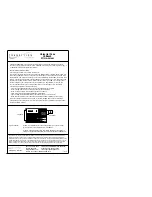
IGNITION NOISE INTERFERENCE
Use of a mobile receiver at low signal levels is normally limited by the
presence of electrical noise. The primary source of noise in automobile installations
is from the generator and ignition system in the vehicle. Under most operating
conditions, when signal level is adequate, the background noise does not present a
serious problem. Also, when extremely low level signals are being received, the
transceiver may be operated with vehicle engine turned off. The unit requires very
little current and therefore will not significantly discharge the vehicle battery.
Even though the transceiver has ANL and NB controls, in same installations
ignition interference may be high enough to make good communications
impossible. The electrical noise may come from several sources. Many possibilities
exist and variations between vehicles require different solutions to reduce the noise.
ANTENNA
A vertically polarized, quarter-wavelength whip antenna provides the most
reliable operation and greatest range. Shorter, loaded-type whip antennas are more
attractive, compact and adequate for applications where the maximum possible
distance is not required. Also, the loaded whips do not present the problems of
height imposed by a full quarter-wavelength whip.
Mobile whip antennas utilize the metal body of the vehicle as a ground
plane. When mounted at a corner of the vehicle they are slightly directional, in the
direction of the body of the vehicle. For all practical purpose, however, the
radiation pattern is nondirectional. The slight directional characteristic will be
observed only at extreme distance. A standard antenna connector (type SO239) is
provided on the transceiver for easy connection to a standard PL 259 cable
termination.
If the transceiver is not mounted on a metal surface, it is necessary to run a
separate ground wire from the unit to a good metal electrical ground in the vehicle.
When installed in a boat, the transceiver will not operate at maximum efficiency
without a ground plate, unless the vessel has a steel hull.
Before installing the transceiver in a boat, consult your dealer for information
regarding an adequate grounding system and prevention of electrolysis between
fittings in the hull and water.
REAR PANEL
17. POWER.
Accepts 13.8V DC power cable with built-in fuse (4 amp.) to be
connected.
18. EXT SP.
Accepts 4 to 8 ohms, 5 watt external speaker to be connected. When
external speaker is connected to this jack, the built-in speaker is automatically
disconnected.
19. PA. SP.
Used to connect a PA speaker (8 ohm 4W) for PA operation. Before
operating PA you must first connect a PA speaker to this jack.
20. ANTENNA.
Accepts 50 ohm coaxial cable with a type PL-259 plug to be
connected.
21. F.C.
This socket is optional for the accessories FREQUENCY COUNTER
model FC-347, to indicate the value of the frequency ranges used.
- 5 -
- 10 -


























